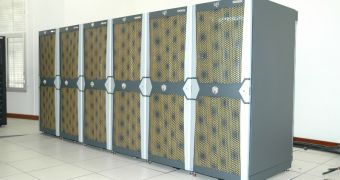Australia seems to be determined to become a major player in the HPC race as the University of Western Australia recently announced that it has acquired a system called Fornax, which is the first step in the development of the country's first petascale supercomputing facility.
Fornax will be located in The University of Western Australia's Physics Building and will be used for data-intensive research in areas such as nanoscience, geoscience and other computational communities.
The supercomputer system procured from SGI is comprised of 96 nodes, each containing two six-core Intel Xeon X5650 CPUs, an Nvidia Tesla C2050 general purpose GPU and 48GB of RAM, resulting in a system containing 1152 cores and 96 GPUs.
The are liked to a 500TB global filesystem, in addition to each node having 7TB of local disk space.
As a distinguishing feature of the supercomputer, Fornax comes equipped with two InfiniBand networks, the first one allowing each node to access the global filesystem, while the second allows nodes to access the local disks on neighbouring nodes.
The networking component of Fornax is comprised of a Cisco Nexus 7009 switch located at UWA to provide layer 3 services, and two Cisco Nexus 5548 layer 2 switches for connectivity to the front-ends of the SGI compute system.
The Nexus 7009 switch includes dual supervisors and M1 linecards for redundancy, and supports a total of 80 SFP- and X2-based 10GbE interfaces.
The Nexus 5548 switches provide a total of 96 10GbE ports at full line rate, and will be connected via a virtual port channel to the Nexus 7009. Furthermore, the SGI front-end nodes will be dual-connected to the Nexus 5548 switches for redundancy.
"Fornax is a machine tailored for data-intensive computing in such areas as radio astronomy and the geosciences,” said Professor Andrew Rohl, iVEC executive director.
"The combination of GPUs and fast local disk distributed between neighbouring compute nodes provides a unique system for our data-intensive researchers," concluded Mr. Rohl.

 14 DAY TRIAL //
14 DAY TRIAL //